|
 Dwight Peck's personal website Dwight Peck's personal website
Ten wintry days in the South of France
Montpellier, Arles, the Camargue, and lots of et cetera
You may not find this terribly rewarding unless you're included here, so this is a good time for casual and random browsers to turn back before they get too caught up in the sweep and majesty of the proceedings and can't let go.
Aigues-Mortes by the sea, sort of
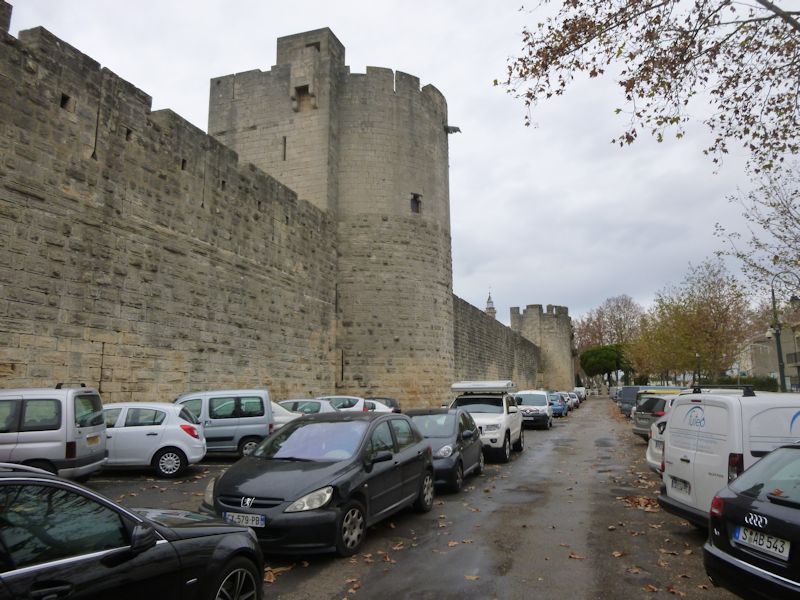
We're here in the carpark just outside the medieval walled city of Aigues-Mortes, a city by the sea but not really, just 20km east of Montpellier, 27 December 2014. The town's name comes from Aquae Mortuae, 'dead water' or 'stagnant water', which pretty much sums up the city's relationship with the sea.
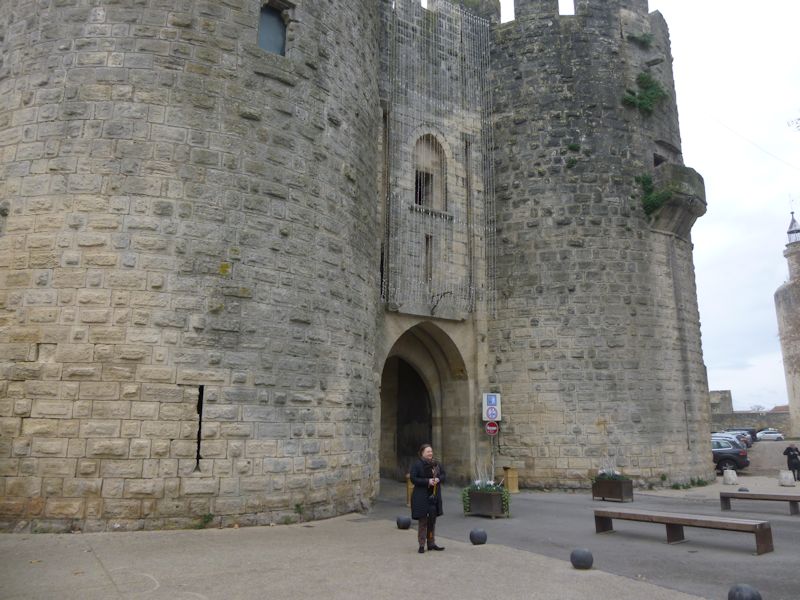
Exhausted after our trek from the car along the city walls to the main gate, on the northern (landward) side, the Porte de la Gardette, we prepare to greet Aigues-Mortes on a rainy afternoon.
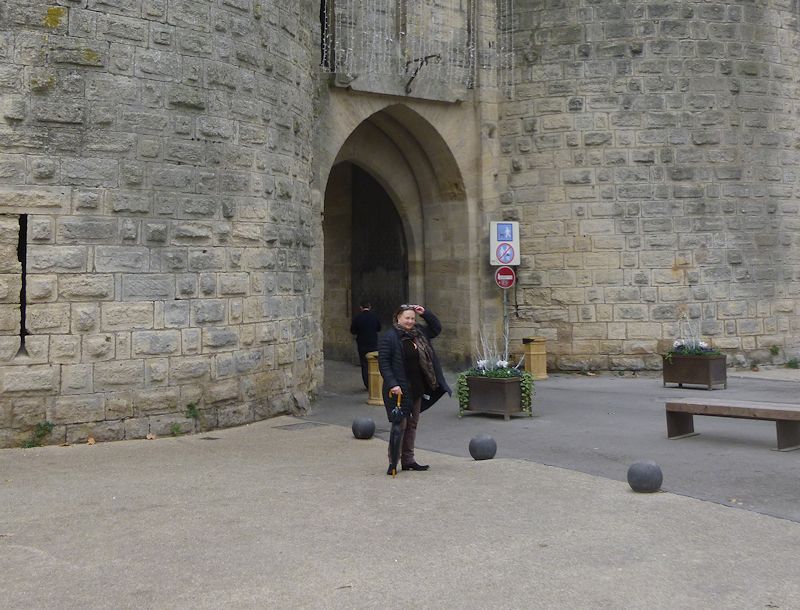
Prime Minister Anthony Eden used to walk about with an umbrella just like that one.
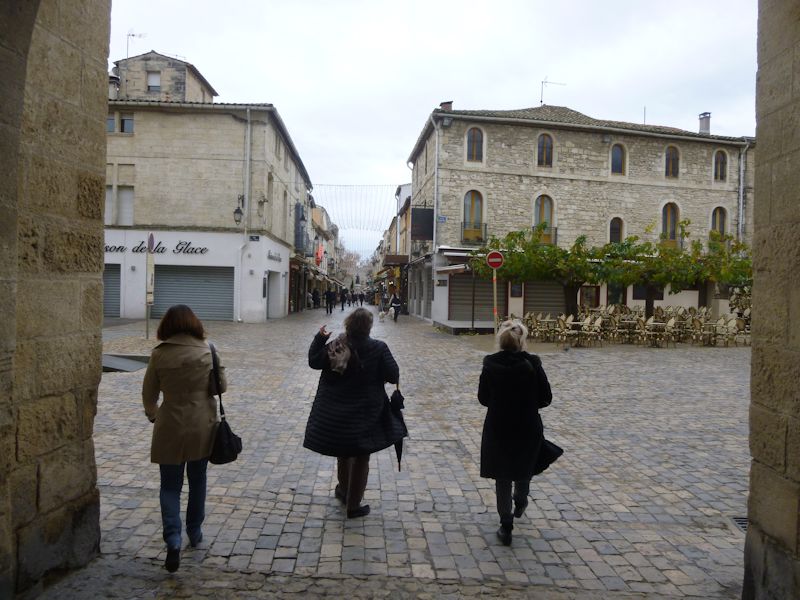
We're in; the gate was unguarded. People were working the salt flats around here in the vast Camargue wetlands at the mouths of the Rhône river from Neolithic and Greek times, but this site was undeveloped until Charlemagne built a defensive watchtower here in 791, to protect the salt workers and provide warning to inland towns, like Nîmes, of emerging military issues.
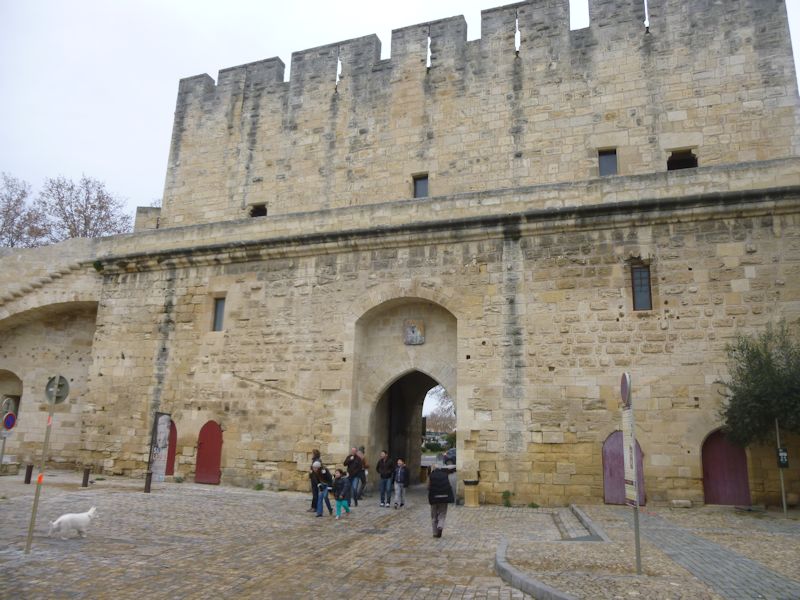
The back of the Porte de la Gardette. In about 1240, the French king Louis IX, later called Saint-Louis, determined to lead a Crusade to the Holy Land, the 7th Crusade as it turned out, but as the Kingdom of France had at that time no access to the Mediterranean, he swapped lands with the nearby Abbey of Psalmody and began constructing his own port here (rather like the Russians in Crimea). The idea was to save the cost of having to hire masses of ships from Genovese and Venetian merchant fleets to float his folks across -- to Egypt, as it transpired, in 1248. That didn't end too well (the Battle of Mansurah, 1250, and dysentery), and he had to hire Italian ships to get there anyway. (Exciting coverage in Thomas Asbridge, The Crusades [2010], cap. 21, and the biography by the king's advisor Joinville.)
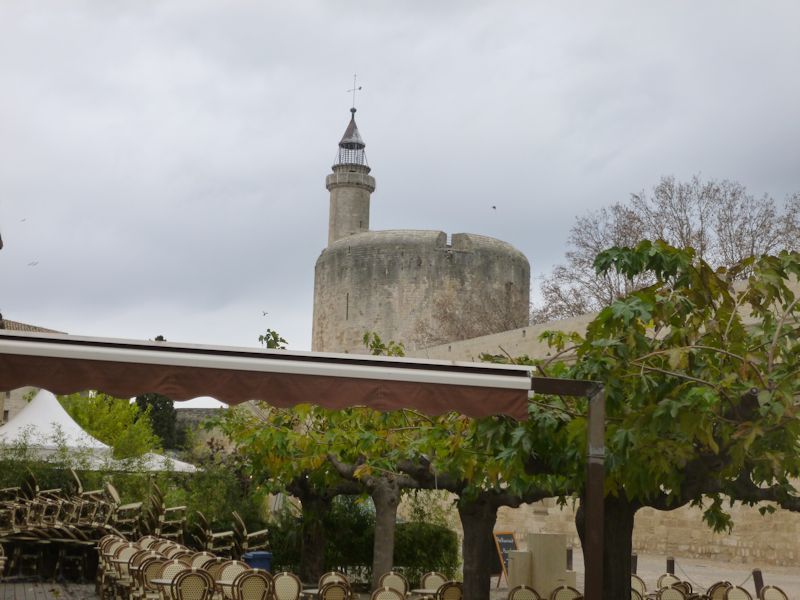
First up was the Tower of Constance, built in 1242-48 on the site of Charlemagne's old Matafère tower, and now all that remains of the castle complex that King Louis built to go with it. (The walls are 18 feet thick and weren't going anywhere.)
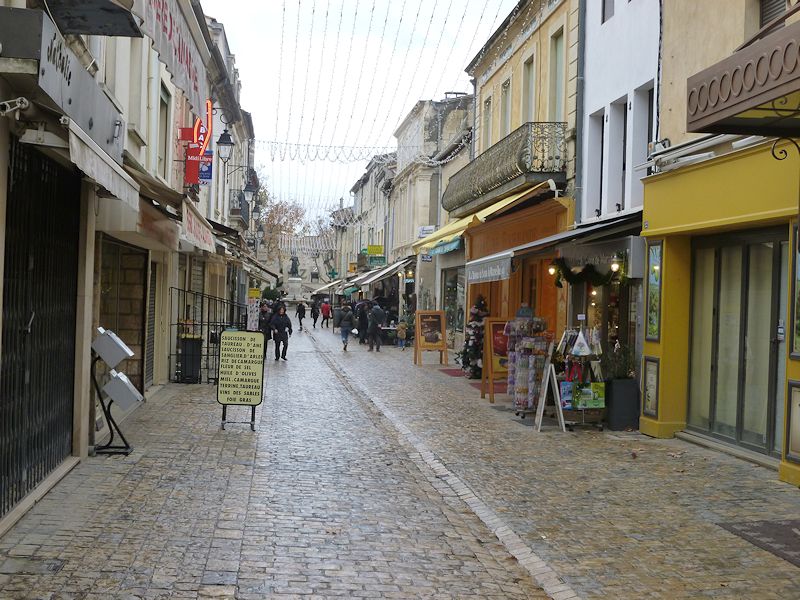
The high street from the main gate to the Place St-Louis, the town centre. Many surviving medieval-era towns now depending upon tourism fill their pedestrian streets with high-end boutiques, but Aigues-Mortes, albeit with its share of artsy boutiques, is also a working town with Casino supermarkets and other normal stuff.
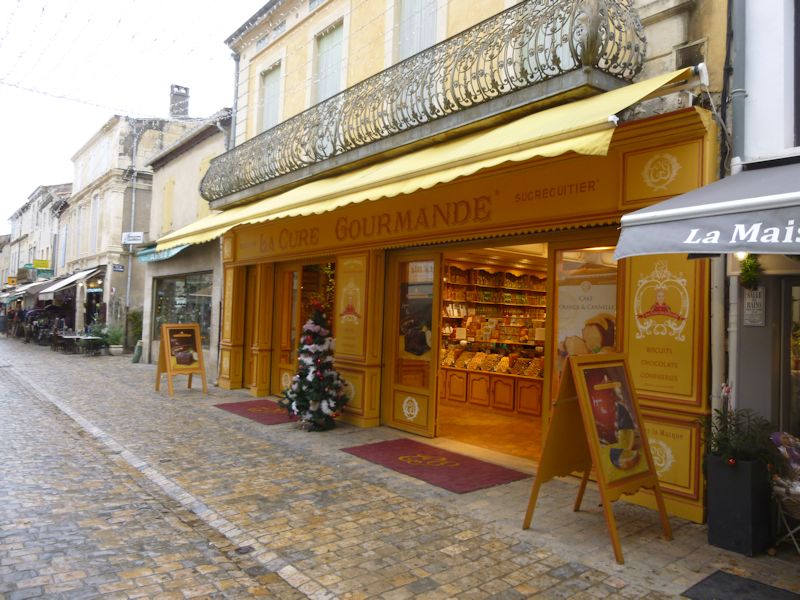
With appropriate attention to the specialties of the terroir, like . . .
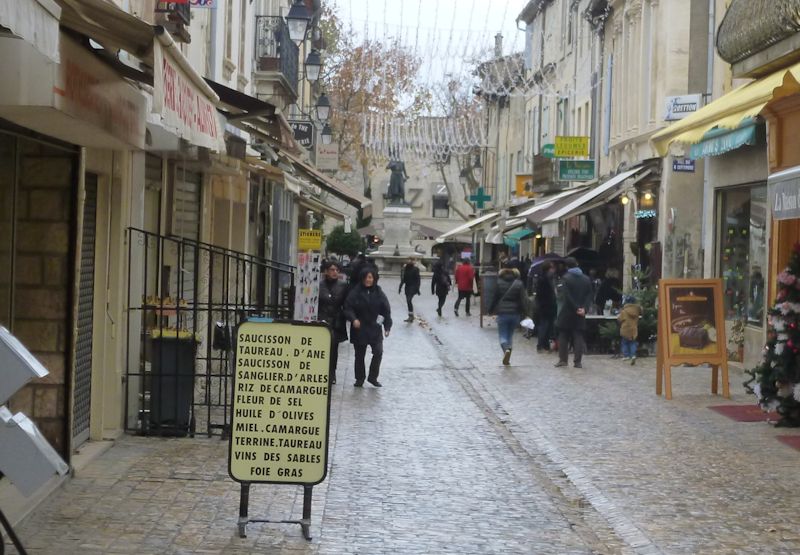
. . . bull sausages, donkey sausages, wild boar sausages, Camargue rice, sea salt flowers, olive oil, honey, the vins des sables or 'sand wines', and of course, the foie gras. But bull sausages??
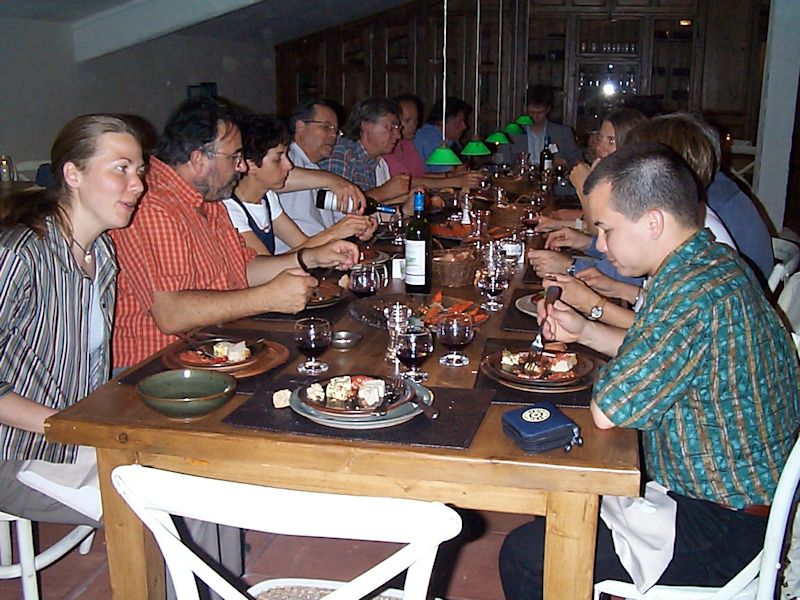
Here's an archival photo of me (5th from the left, looking stunned) trying out the bull sausages in the Camargue in 2001. |
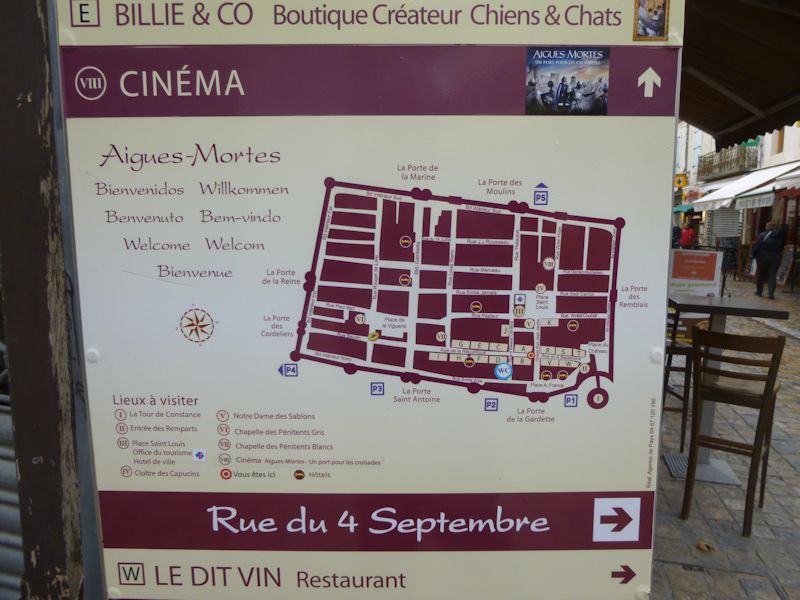
A plan of the city. The king attracted new citizens to his new Mediterranean port in a malarial wasteland by exempting them from various taxes, etc. But it was his son, Philip III 'the Bold', who began the construction of the city walls and towers after Saint Louis died in his second shot at a Crusade (officially, the 8th Crusade), which got him as far as Tunisia this time, where (dysentery again) he died in 1270. And it was that son's own son, Philip IV 'the Fair' who completed the project at the end of the century.
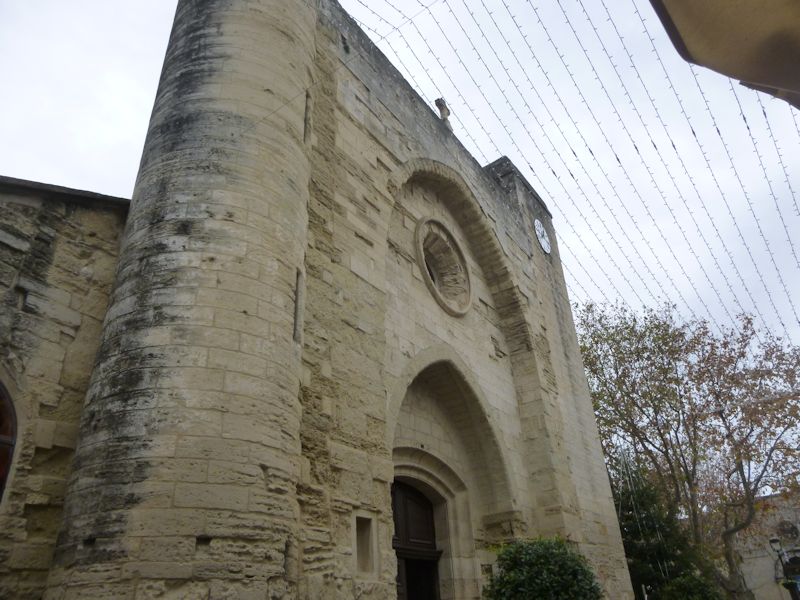
Adjacent to the Place St-Louis, the church of Notre-Dame-des-Sablons, which probably predates the construction of the city walls and infrastructure. 'Our Lady of the Sands', no kidding.
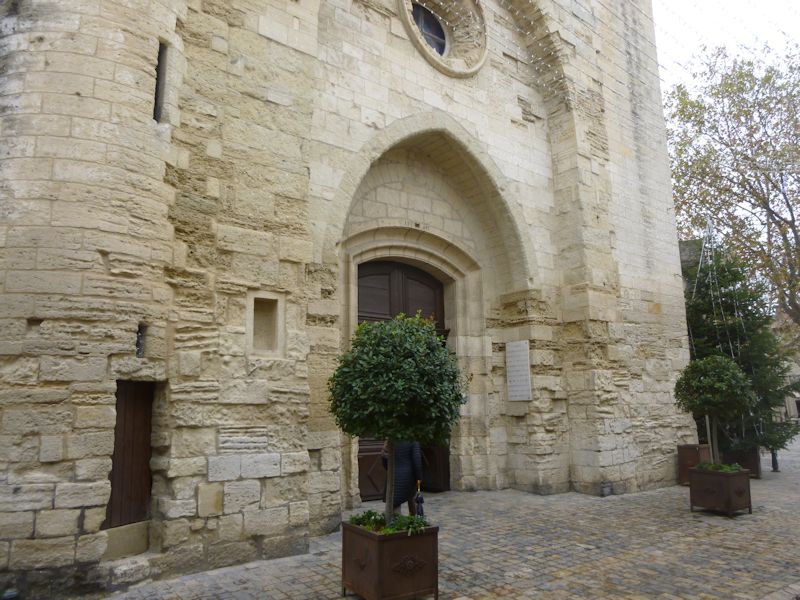
Notre-Dame-des-Sablons

A beautiful simple nave with side aisles but no transept -- it was wrecked by the Huguenots in 1575 (whose descendants ended up imprisoned in the Constance Tower, with the key thrown away, in the 17th and 18th centuries) and turned into a "Temple of Reason" during the French Revolution, and then of course a military barracks, warehouse for salt, etc.

Temple of Reason, indeed. At least they never used it for a prison; they had the Constance Tower for that, just two blocks over.

In the 19th century, it was gussied up to suit contemporary Neo-neo tastes, but all of that was carefully removed in the 1960s, so now we're back to the beautiful basics. With a statue of St-Louis stuck on the wall as a grace note.
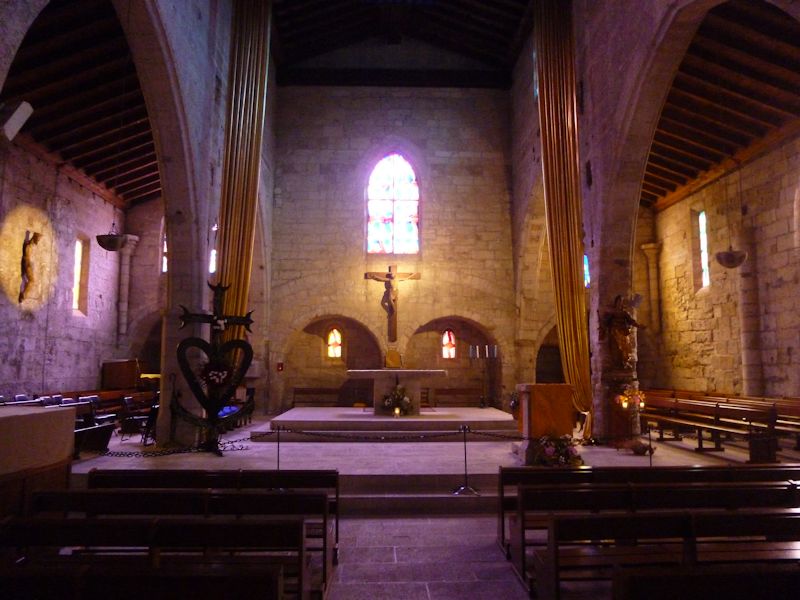
A raised presbytery and simple altar, with stained glass added in 1991.
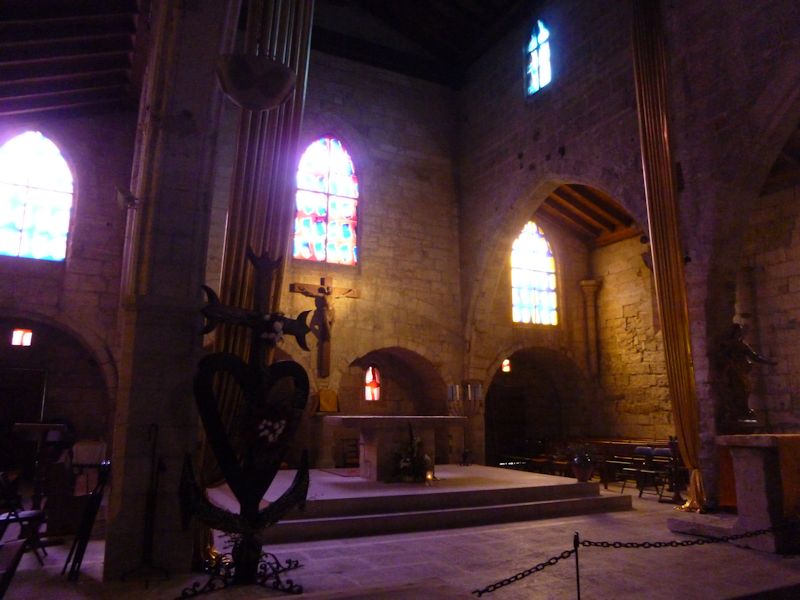
Very nice indeed
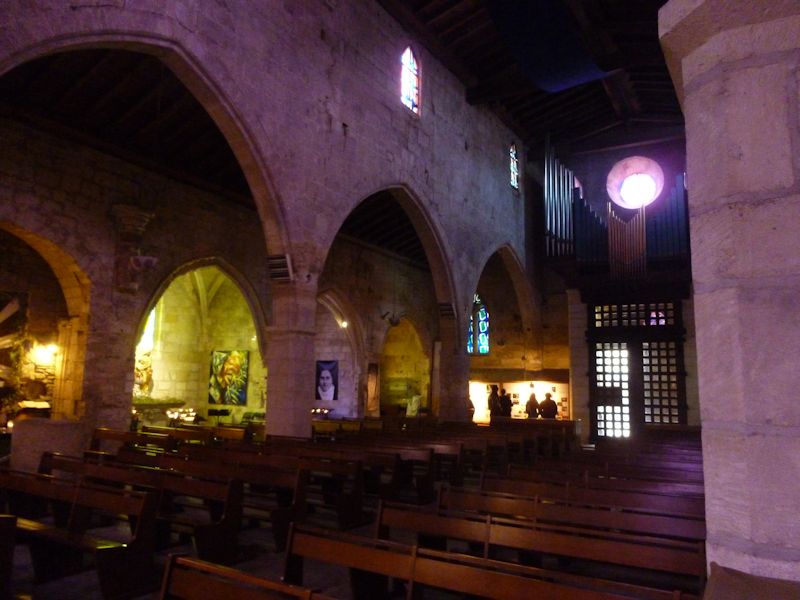
We have to leave now, cutting short our spiritual meditations, in order to get some quality sightseeing in before lunchtime.
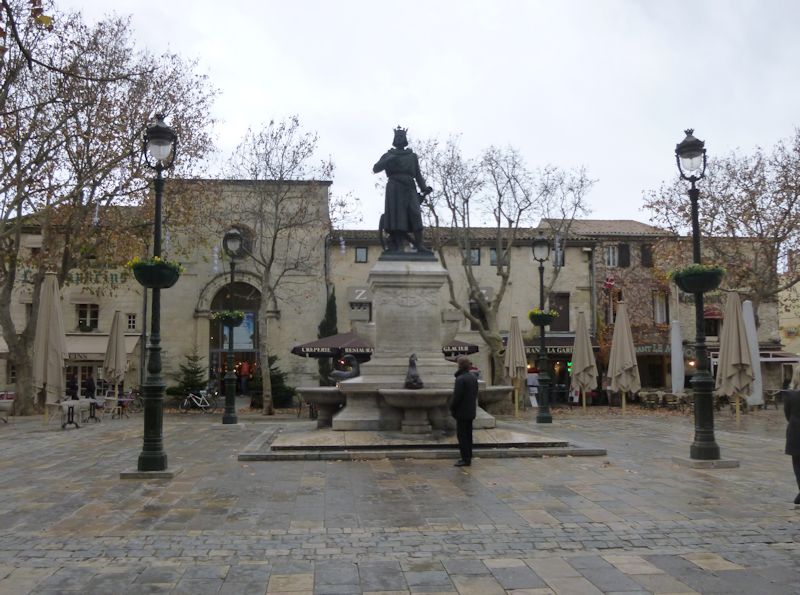
Guess who? In the central piazza, there's our Warrior Saint, Louis IX. Inspiring us to grand exploits.

There's no harm in checking out the menus as we wander lonely as a cloud round the old town. We're not too interested today in the 'Bull on a Plank', but we'll be back shortly for the special on the moules for Kristin and a good old-fashioned ham-and-cheese for me.
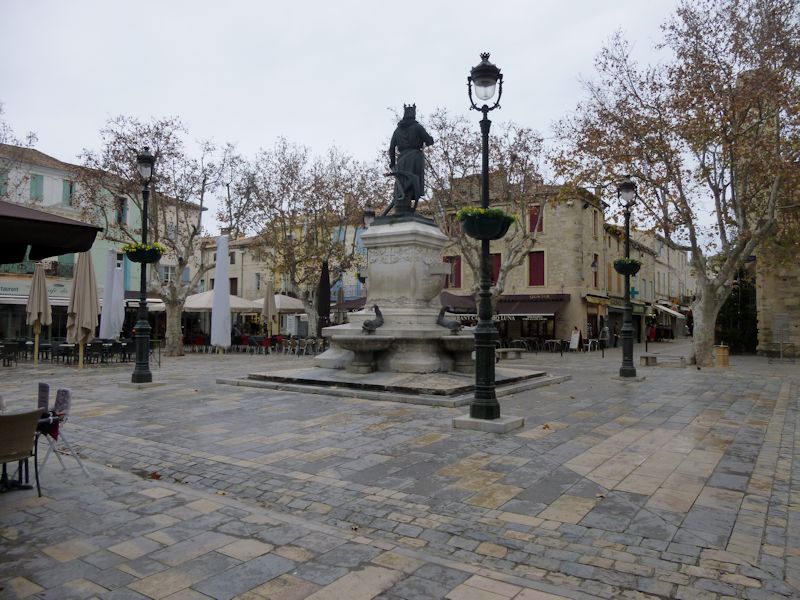
Saint Louis is everywhere here! It's like we'll never see the back of him. Oh, we just did.
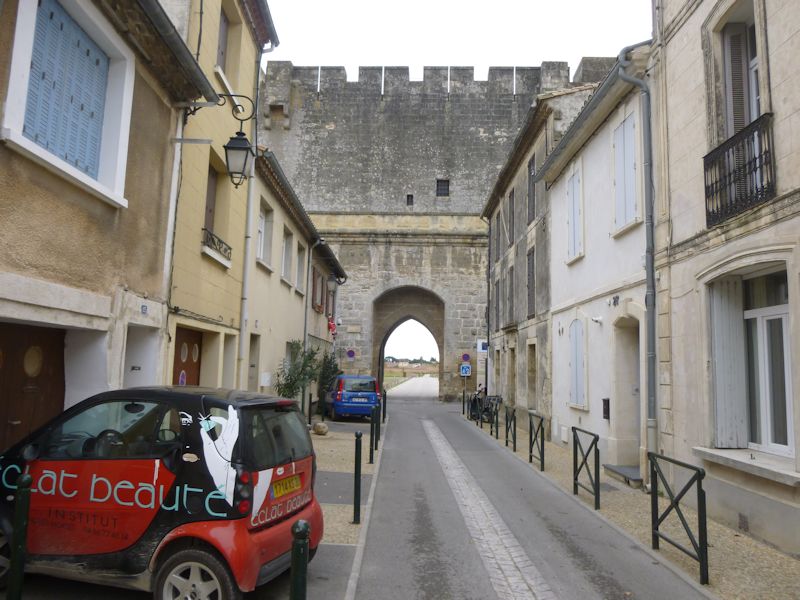
The southern gate, the Porte de la Marine, looking out over that vast spread of salt flats, used and disused canals, tiny islands and hundreds of étangs or ponds more or less connected to the sea in baffling ways.
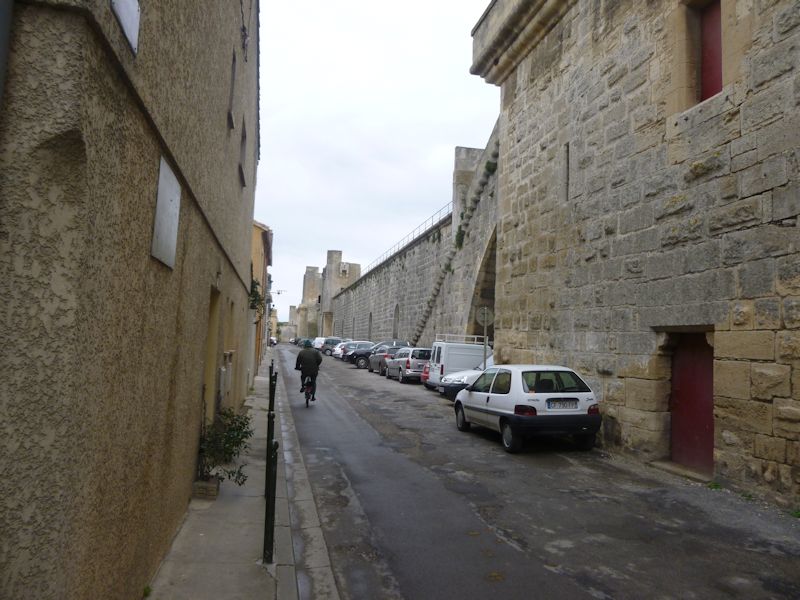
A look along the Boulevard Intérieur that runs all the way round the town inside the walls.
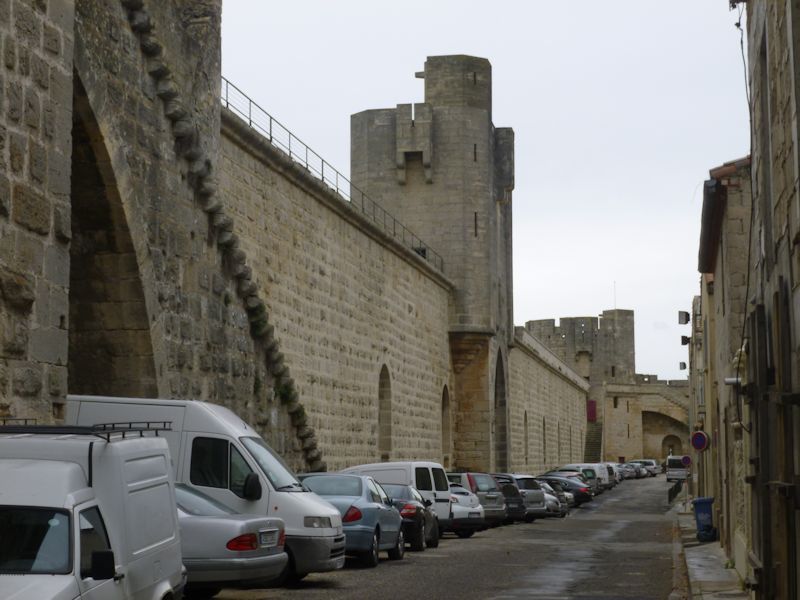
The Boulevard Intérieure in the other direction. After our moules and ham-and-cheese, we'll be doing the 1.6km Wall Walk and everything will become clear. All questions will be answered. Many desires will be gratified.
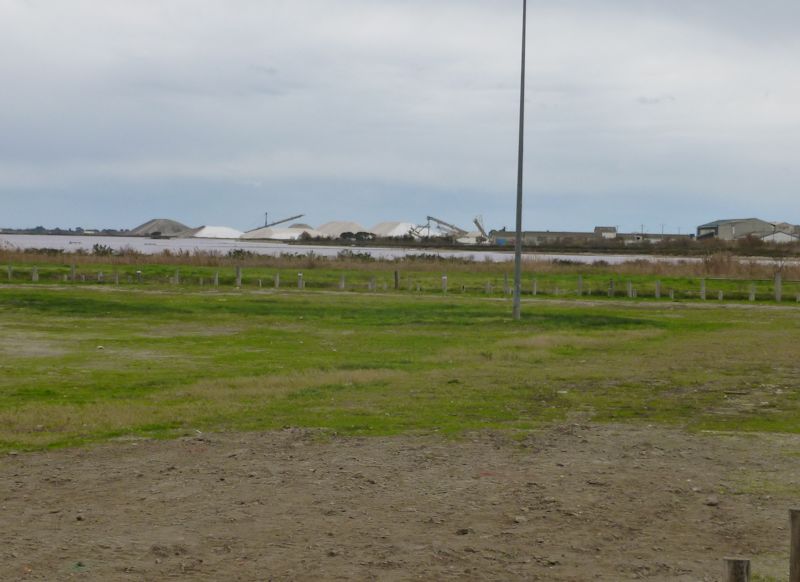
The salt works south of town, in the Étang de la Ville, or City Pond. I'm not sure that I know the difference between sea salt and mined salt, but I prefer sea salt anyway -- perhaps only because it supports a traditional way of life that also pays for the conservation of the wetlands. Many coastal Mediterranean and Atlantic Ramsar Wetlands of International Importance are now commercially successful for their Flowers of Salt products.
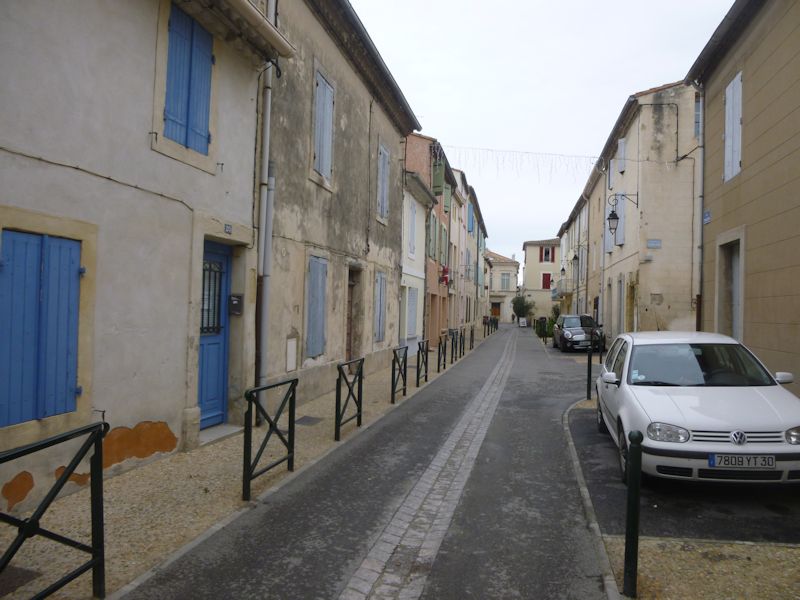
Back streets of Aigues-Mortes
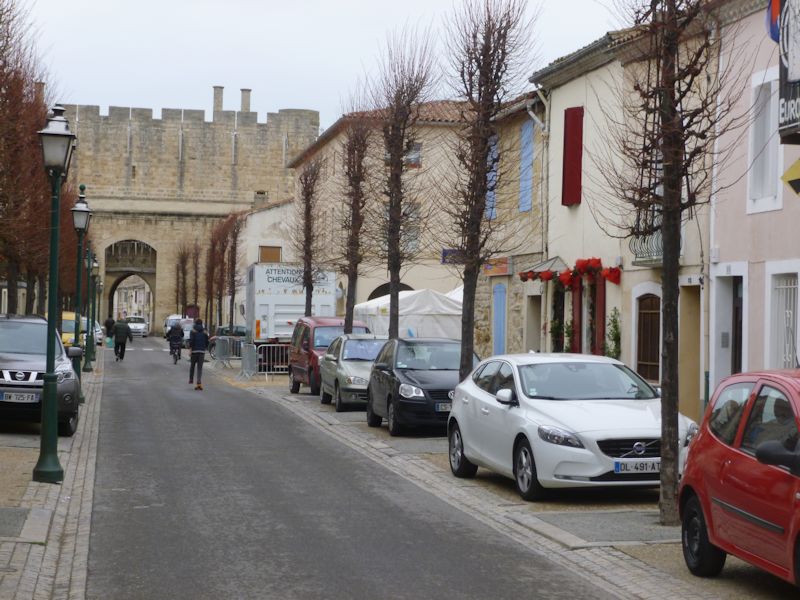
Sadly, the economic growth of Aigues-Mortes as the Kingdom of France's only Mediterranean seaport met an early end, when in 1481 the Provence region was added to the royal domains and the established port of Marseilles (since ancient Greek times) filled that niche ably.

Let's just check the menu here -- just in case.
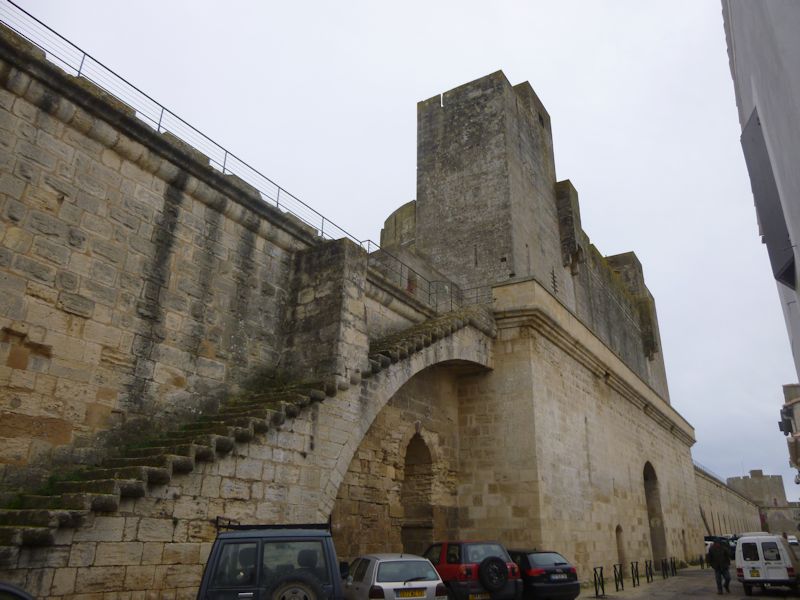
The towers along the eastern walls, the Porte de la Reine. This is where the worst to-and-fro and casualties between the Catholics and Protestants took place.
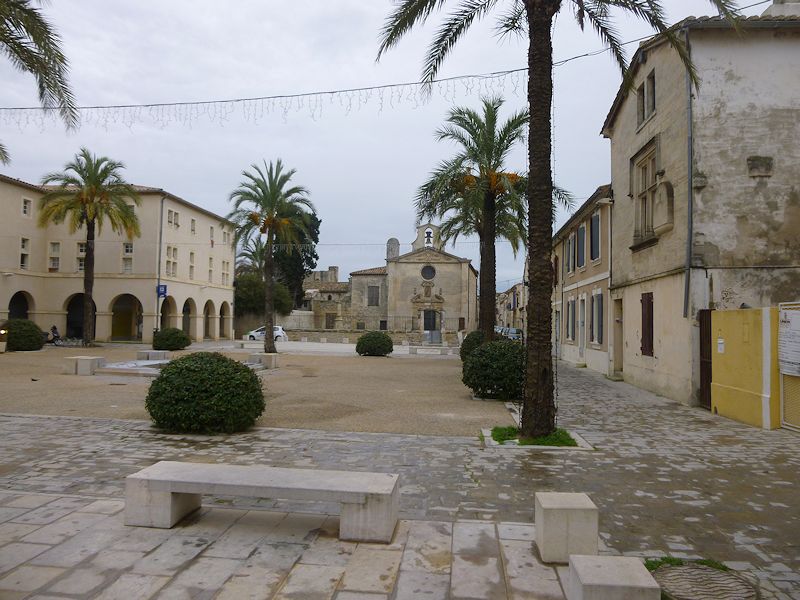
The 17th century Chapel of the Grey Penitents, who still own it. (Visits available for true penitents (grey).)

Kristin with the cute geese, chickens, donkeys, and what not
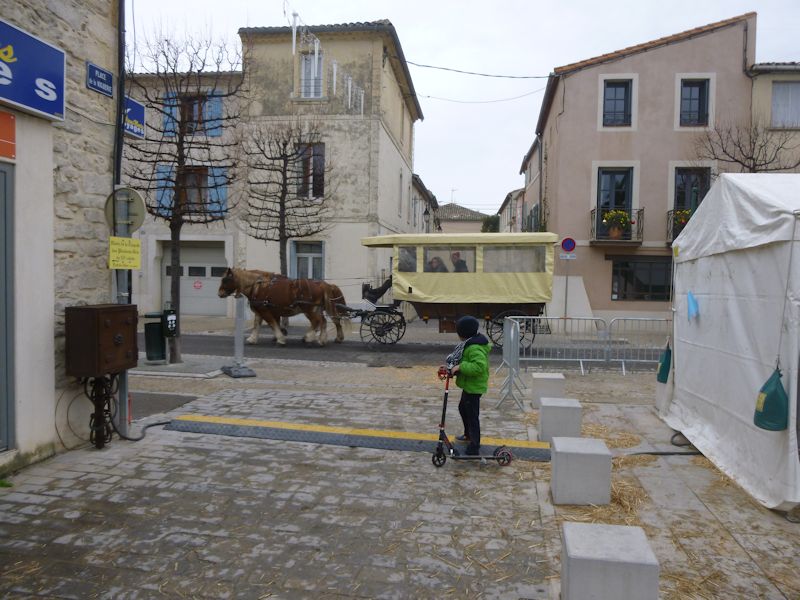
A festive sightseeing tour in the rain. There is a regular little tourist train taking people out to the salt marshes, a Dotto Muson River F5 by the look of it, but it's evidently out of service in the winter.

We've seen the chapel of the Grey Penitents. This is the Chapel of the White Penitents, the building dating from 1625. The White Penitents were a splinter group of penitents off the Grey Penitents, and at one point briefly had the running of the city.
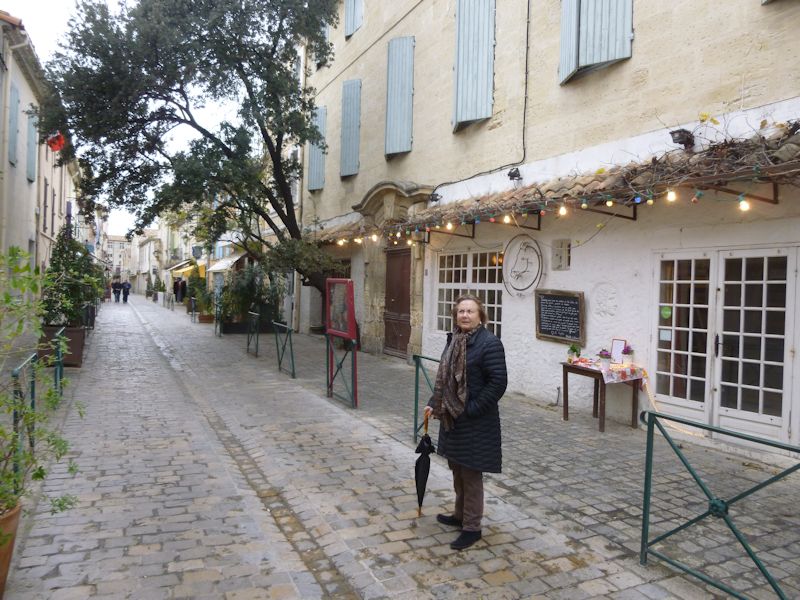
-- White Penitents, you mean those guys who dressed up like . . .

-- Yes, that's they. |
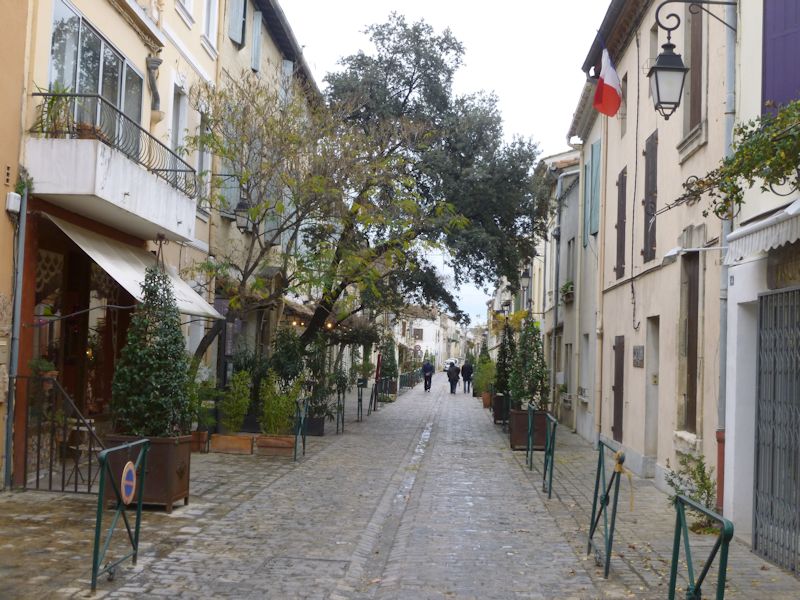
La Rue de la République, back towards the town centre at the Place Saint-Louis

Street scene near the cigarettes store "Le Maryland"
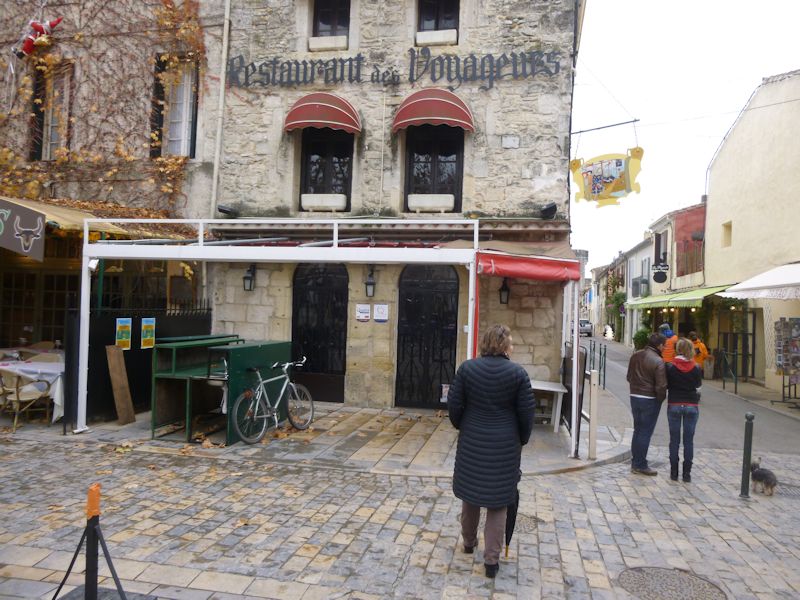
Nearly adjacent to the Place St-Louis
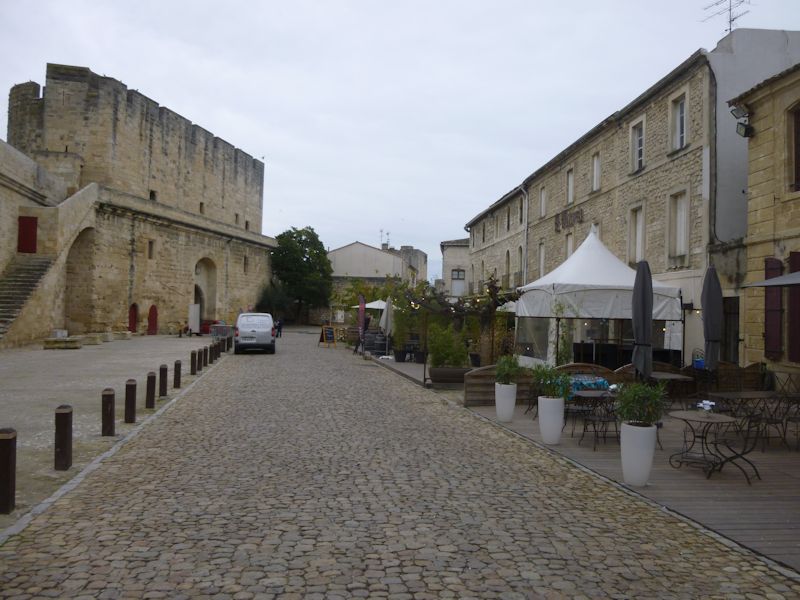
The tower viewing and wall walk doesn't open until 14:00, so we've got time for a little snack -- back to the Place St-Louis again. For the special on moules. And the ham-and-cheese.
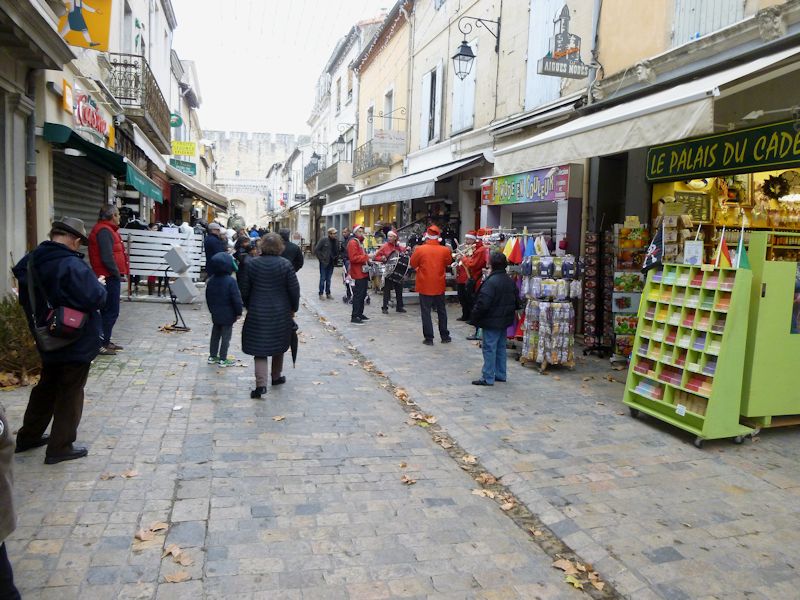
After which, we thread our way through fanfare bands and return to the museum near the Constance Tower
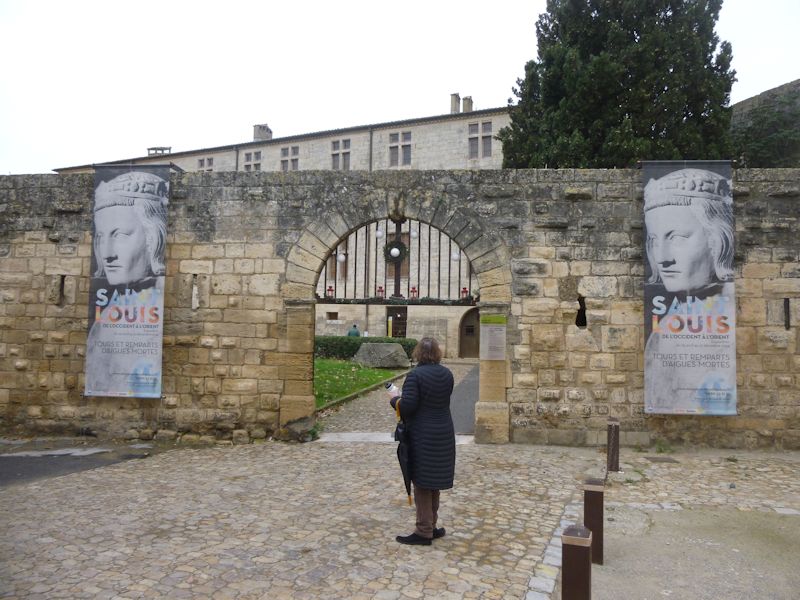
This northwestern corner of the old city was basically the citadel, housing the king's palace, the place d'armes, and the donjon or keep, i.e., the Tower of Constance, with its garrison.
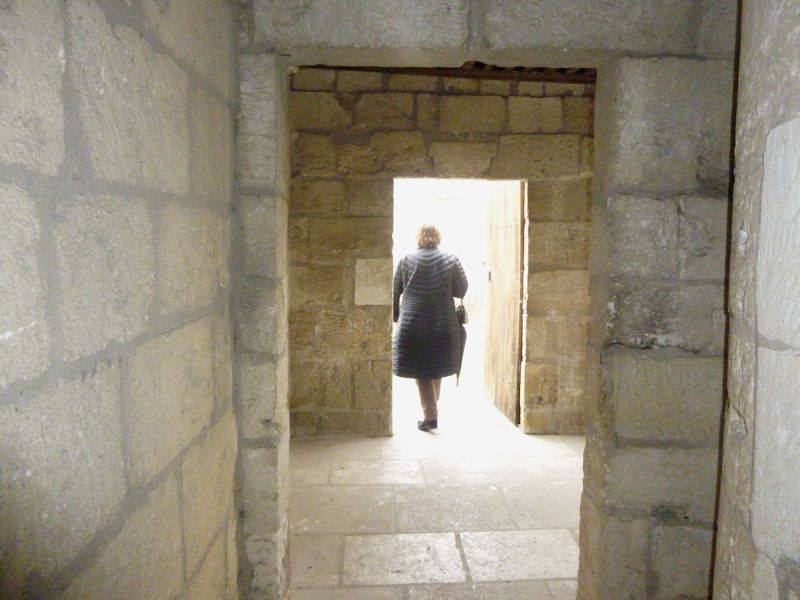
Here we go (only €7.50, worth every pfennig)
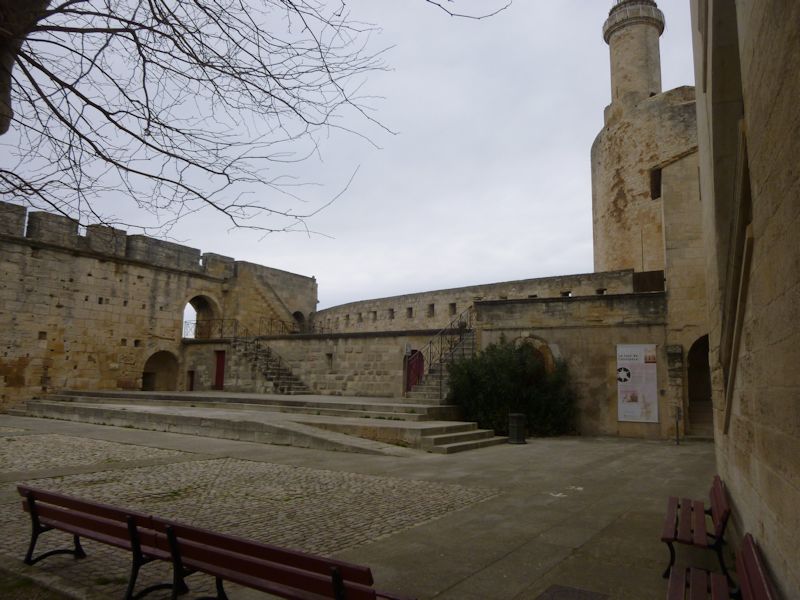
The courtyard attached to what is now the 17th century Governor's Palace, the city wall, and the Constance Tower
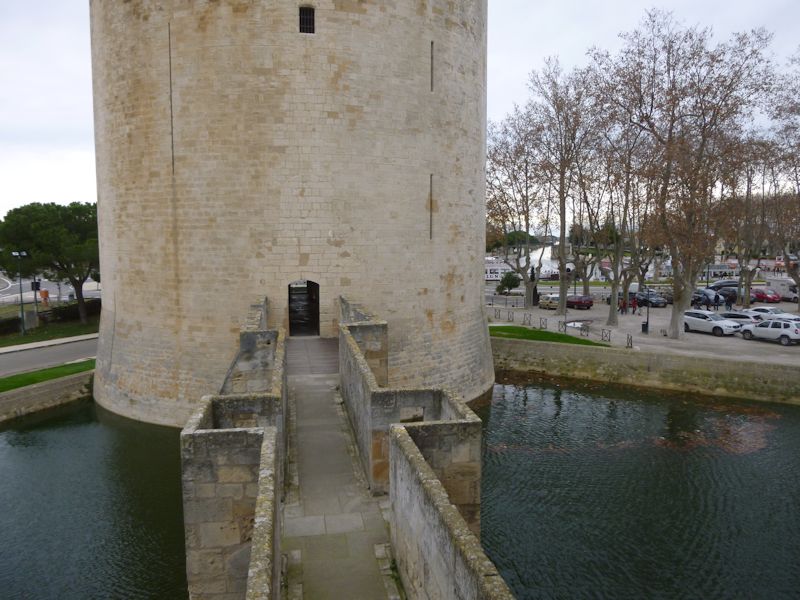
The Constance Tower, 22m across and 30-something metres high, with its own moat, built on Saint Louis' orders from 1242 to 1248, or 1254 (a matter of definitions).

It was the military centre of the early town, housing the garrison, and later (of course) a prison.

A portcullis awaits us at the only door.
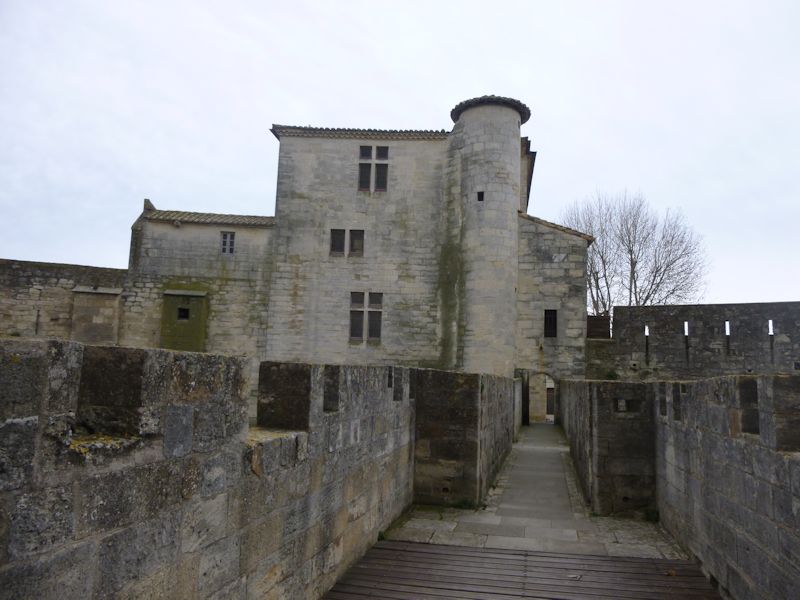
Looking back from the Tower: this is the 17th century Governor's Palace, replacing the wreck of the old King's Palace that was destroyed by a fire in 1421.
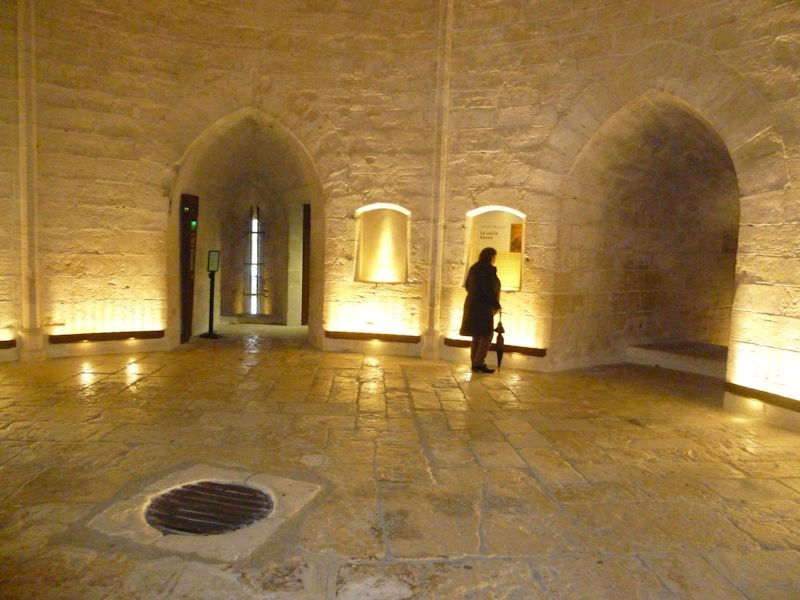
The ground floor, a huge guardroom, with a shaft down into the cellars to the kitchens, ammo dumps, and dungeons.
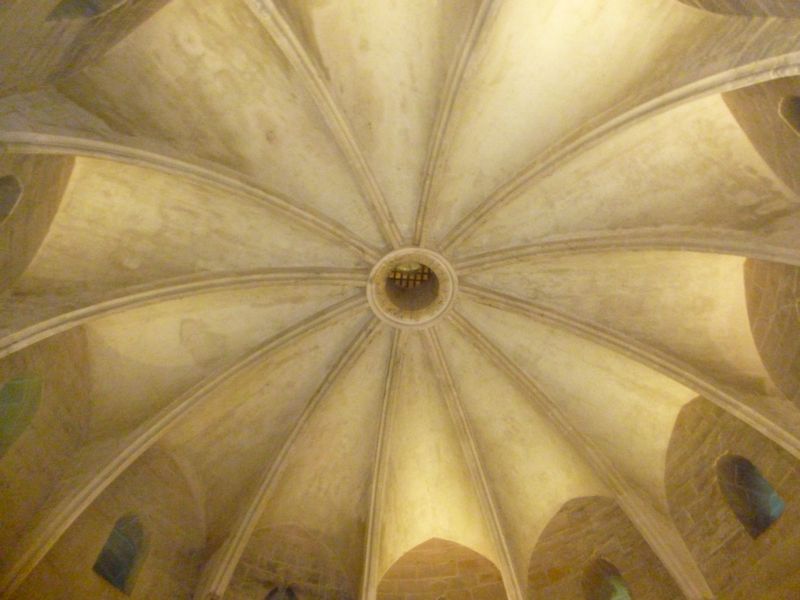
A vaulted roof over the guards' room, with the central shaft continuing above for hauling stuff up, and tossing down what's left over. (No worries, the latrine is built onto the outside wall. Over the moat.)
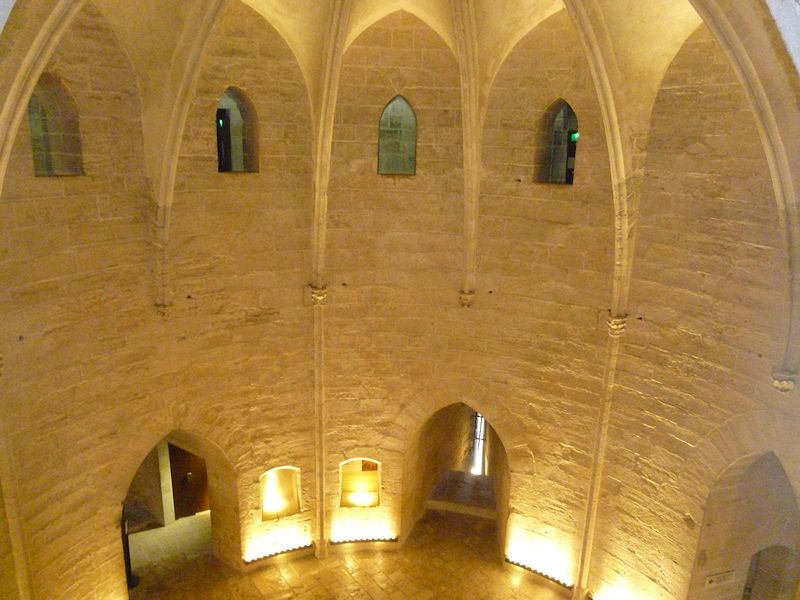
There's an elevator available nowadays, but we're tramping up the narrow spiral stairs in the thick walls that look out over the guardroom below.

The only other room, the Knights' Hall so-called, above the Guards' Room. Following Louis XIV's revocation of the pro-toleration Edict of Nantes (in his vile Edict of Fontainebleau, 1685), matters became really difficult for the Huguenot Protestants everywhere, but especially in this region, one of their strongholds. And this room is where a lot of them were stored.
The most famous of them, Marie Durand, spent 38 years here (until 1768) and carved "résister" in the stonework, thereby becoming famous. During the Camisard guerrilla war against the Catholic government in the early 18th century, one of its leaders Abraham Mazel was also imprisoned here, but snuck out in 1703.

From the roof of the Constance Tower. The surroundings of Aigues-Mortes, as part of the vast Camargue delta of the big and little rivers Rhône, silt up a lot and always have. The economic and political importance of the town has always depended on canal building. This one leads northeast to the Petit Rhône and thence to the city of Arles.
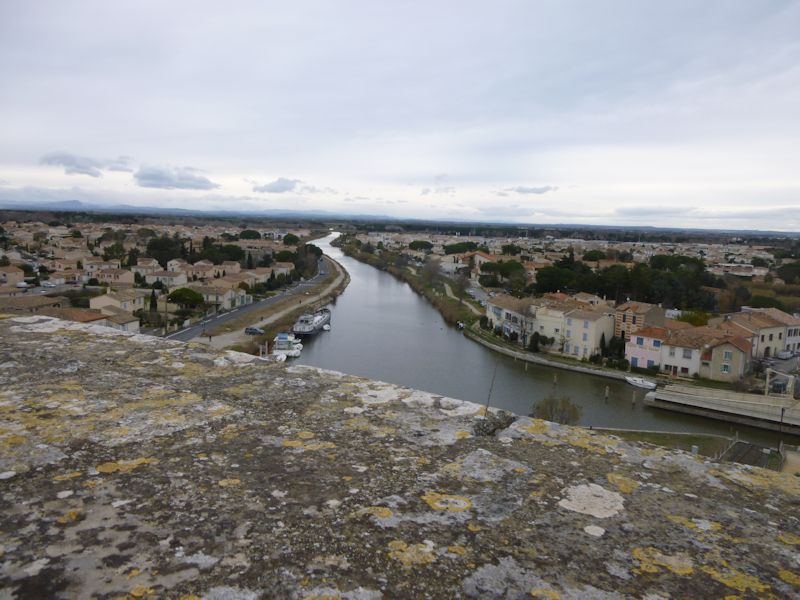
And this one is a spur that leads to the Canal du Rhône à Sète, which is a town way, way down the coast near Montpellier, part of the Canal du Midi system.
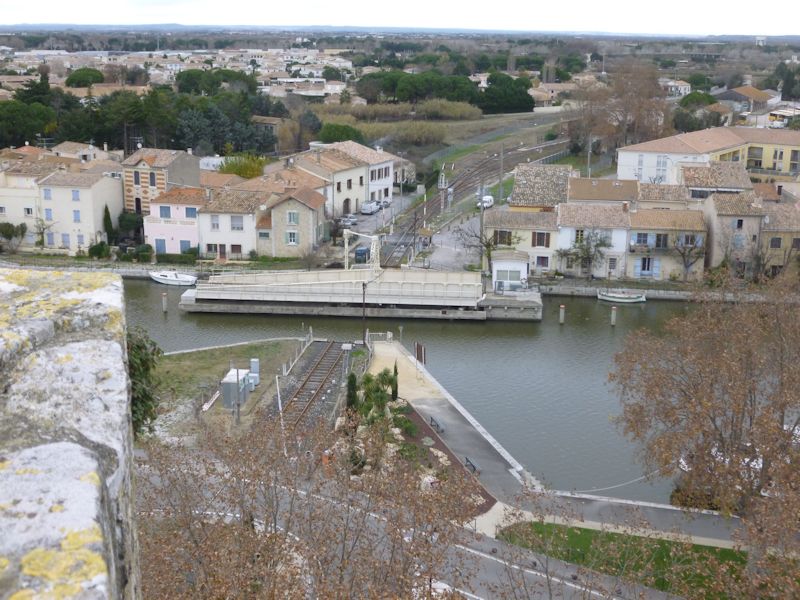
And there's a swivel bridge for the local rail line from Nîmes (mainly for the sea salt)

And that canal (still called part of the Canal du Rhône à Sète) leads out to the Mediterranean at Le-Grau-du-Roi.
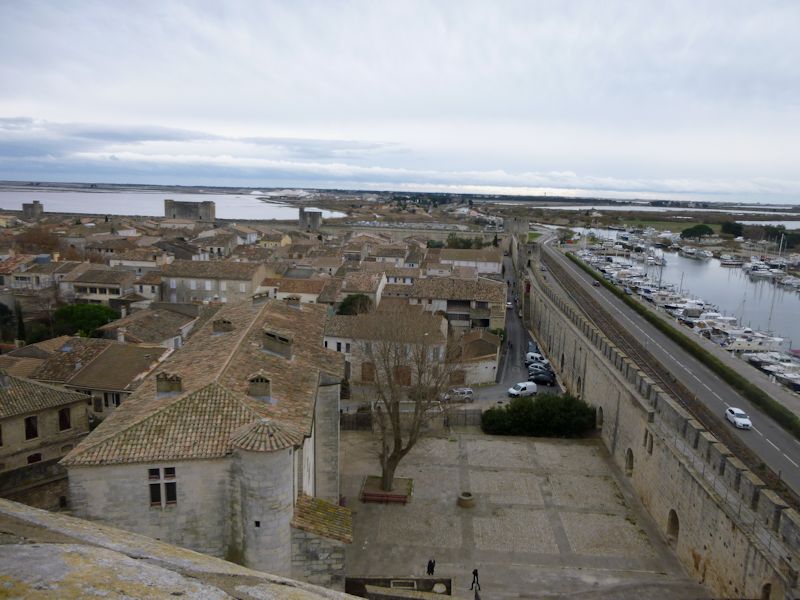
And that's a look at the Governor's Palace below and the old town's western and southern walls, with the various étangs and salins or salt works out on the Camargue marshes.
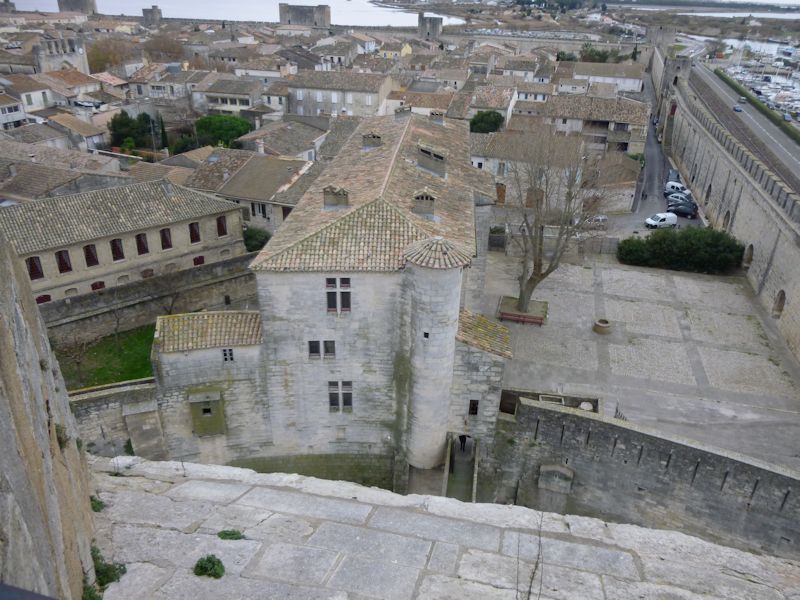
The Governor's Palace
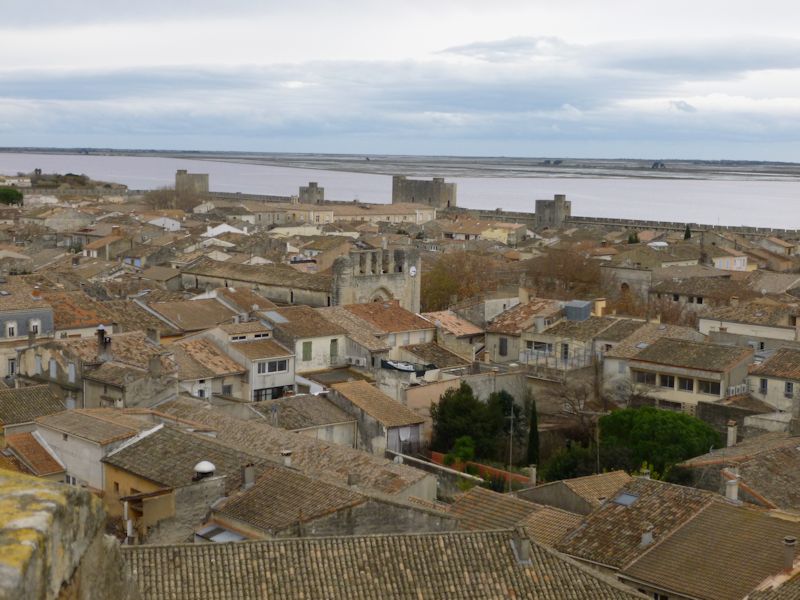
Downtown Aigues-Mortes and the étangs beyond. The church of Nôtre-Dame-des-Sablons is in the centre.

We commence our wall walk: that's the main gate before us.
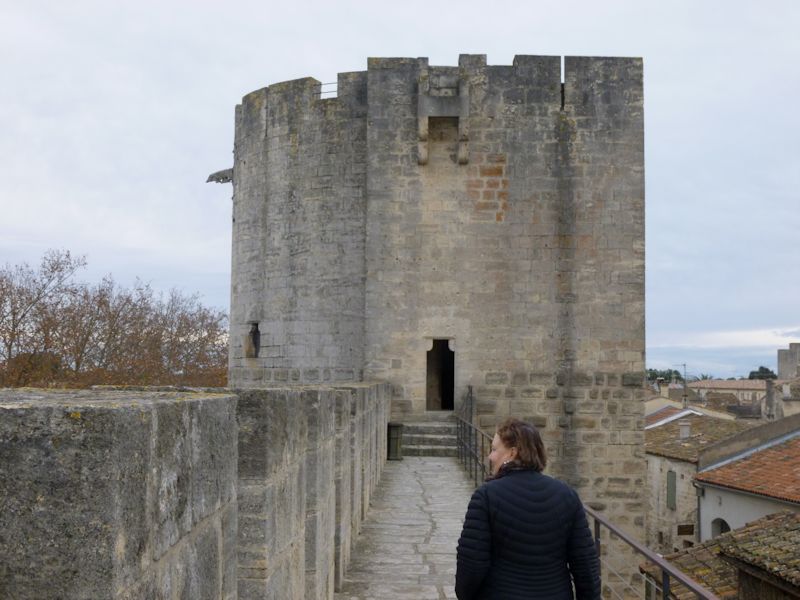
And that's the next one, the Tour du Sel (presumably used for storing commercial salt at some point)
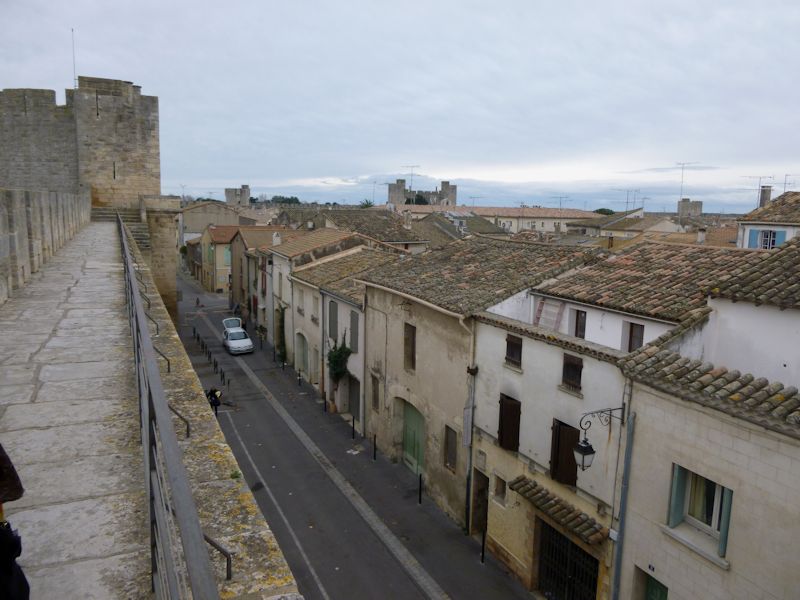
We continue along the northern wall, a 1.6km stroll all the way round, with educational displays in nearly every tower; and of towers there are many.
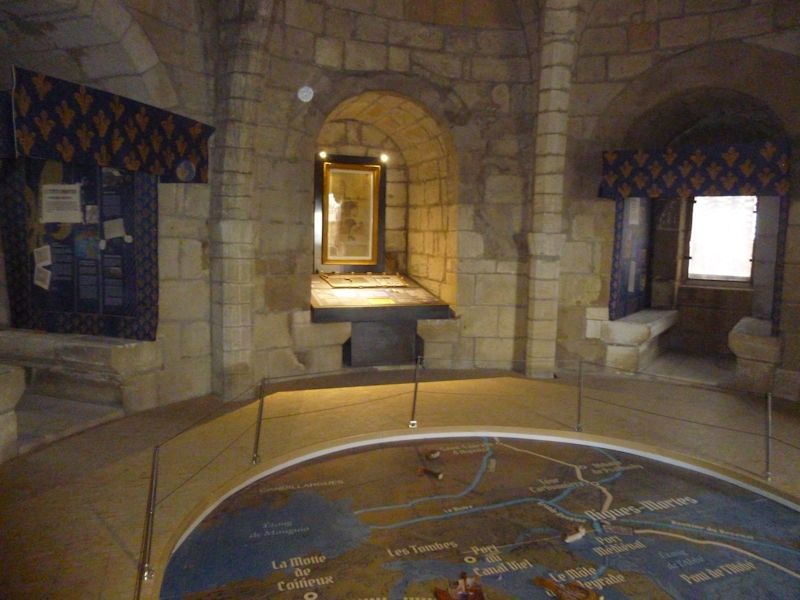
Like this one
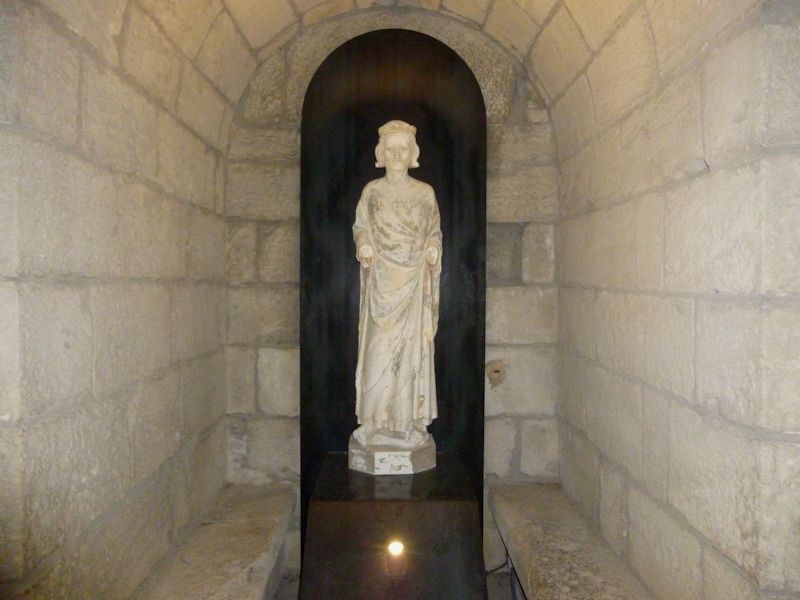
Saint-Louis hisownself

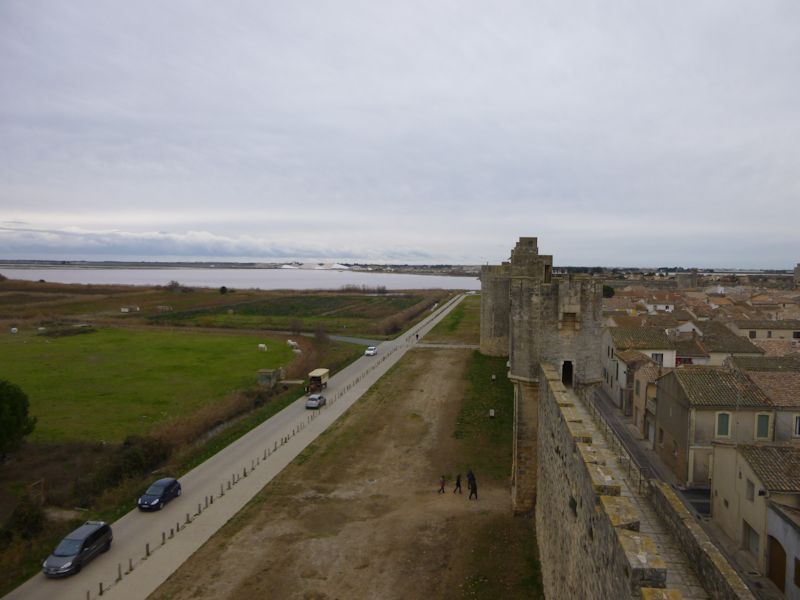
The eastern wall, looking out at the étangs of the Camargue. The economic benefits of the salt works were not always equitably distributed; in 1893, complaints from the local seasonal salt workers about cheaper laborers coming from Italy led to a very unfortunate massacre of the Italian workers. "This was the largest massacre of immigrants in the modern history of France and also one of the biggest scandals in its judicial history," according to Wikipedia's sources.
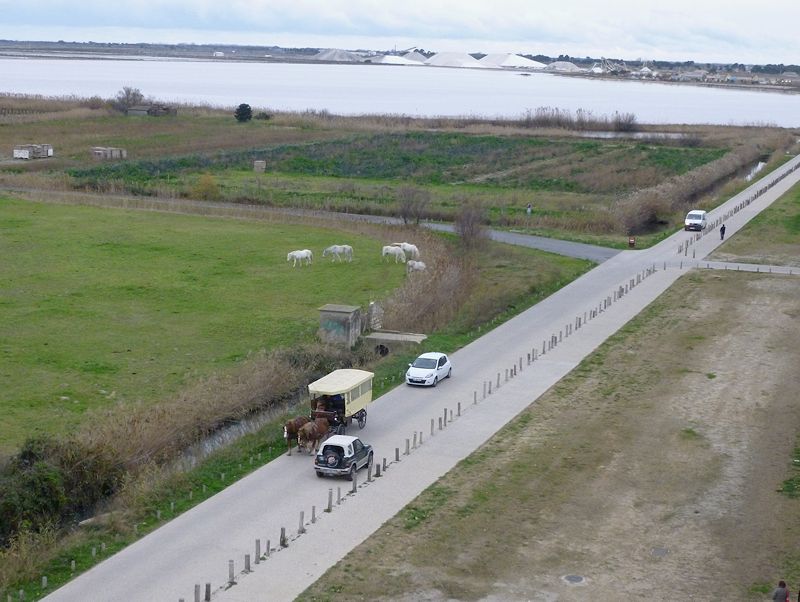
Below, in addition to our festive rain-soaked sightseer wagon, we see some of the white horses for the raising of which the Camargue is so famous. As well as bull raising, in fact, mainly for the lively bullfighting trade throughout this region. And flamingos (not seen here), who just come along from Kenya when encouraged to do so by conservationists at the Tour du Valat Biological Station.

The Queen's Gate on the eastern wall
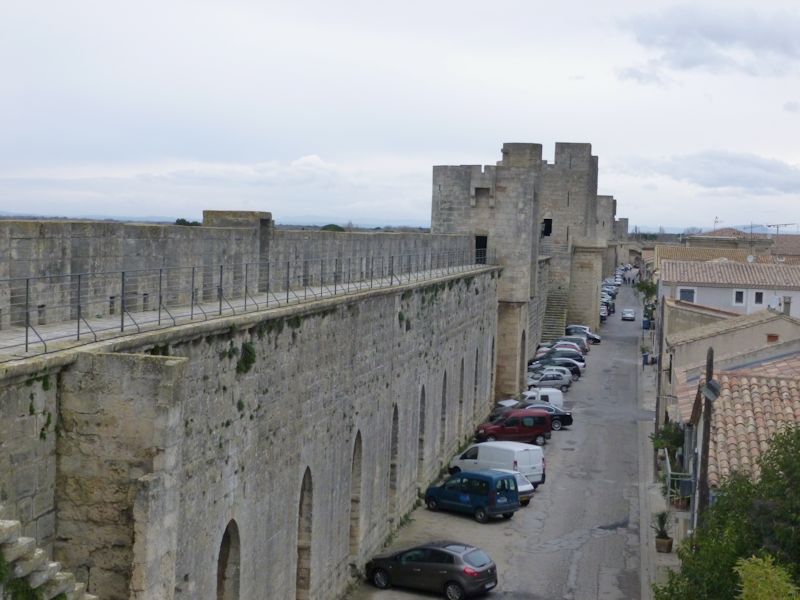
The southern wall, and the Porte de la Marine, or sea gate, to which, back in the day, flat-bottomed boats could tie up to the pier.
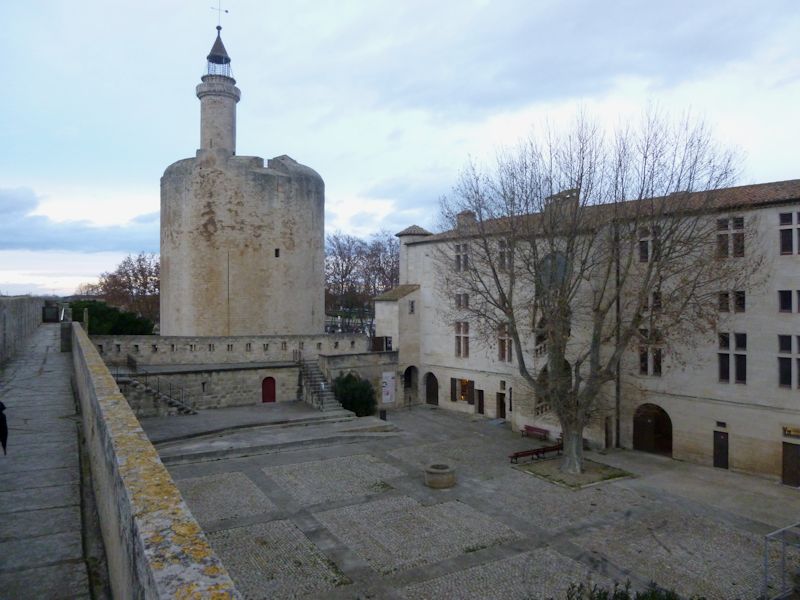
We're completing our circuit of the walls, back at the Constance Tower.
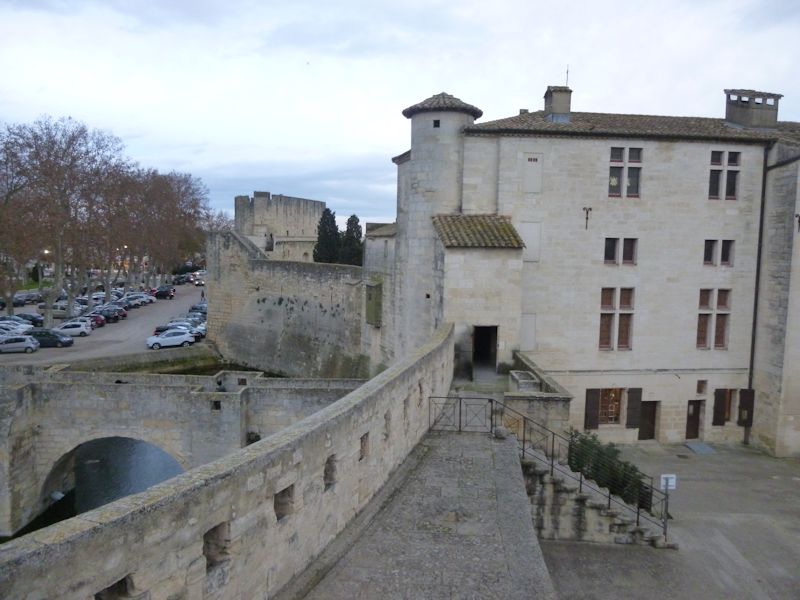
We're at the Governor's Palace again, and so back out to the carpark, and off we go to home. This was our one night to dine happily at the restaurant Le Midi-Teyranais in Teyran, open only one night a week at this time of the year. Tomorrow: Montpellier, for the Saturday flea market.
      
    
 Feedback
and suggestions are welcome if positive, resented if negative, Feedback
and suggestions are welcome if positive, resented if negative,  .
All rights reserved, all wrongs avenged. Posted 30 January 2015. .
All rights reserved, all wrongs avenged. Posted 30 January 2015.
|
 Dwight Peck's personal website
Dwight Peck's personal website








































































